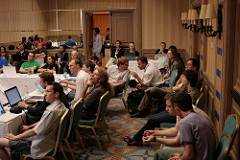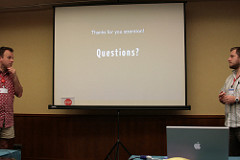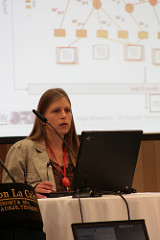I have 65 invitation tickets for twine.com. Ping me via #swig on freenode, jabber, skypeto:leobard or comment your mail address on this blog post to get there.
Gender and Subjective Views in the Semantic Web
You know the Semantic Web is mature when it is subject to gender studies.
Marion Fugléwicz-Bren (the public relations representative of semantic web company) interviewed Corinna Bath, a researcher and lecturer, about gender studies and Semantic Web.
The arguments are valid, going along the lines that social group and background influence the interpretation of reality. Its interesting to see what the problems are, and possible solitions, from her view:
three quotes I need for an argument:
Another line of thinking about gender and the Semantic Web is feminist epistemology, which questions traditional approaches in pointing out that there is no “real meaning”. According to these findings knowledge is always historically and culturally situated.
Hence, in contrast to its own agenda CYC ignores minority views, quieter voices, and allows the dominant voice to speak for everyone, which seems highly problematic.
Even the modelling concepts themselves should be questioned as Cecile Crutzen suggest, since e.g. the class concept and the inheritance concept lack to represent social processes, because of limited formal expressiveness for conflict, change and fluidity. Such an ontology abstracts from human sociality, situated action and real meaning construction processes.
The views are also supported by constructivistic philosophy (which I basically agree with and adhere to in my own work on Personal Information Models) with the core principle that reality is constructed inside the individual based on sensory input.
The suggestion to contextualize statements and ontologies is also right. Technial there are two problems: inference and identification. The problem is that inference as-is-now is already a hard problem, and using localized/contextualized ontologies as done by Stefan Decker and Michael Sintek in their 2002 Micro-Inference approach in TRIPLE (or by Nepomuk’s NRL theory) makes the problem even harder.
Second, if a user would benefit from a contextualized ontology, the user would have to identify himself and give away information about his social context, gender, sexuality, nationality, preferences, which is a privacy problem.
So – who comes up with a solution? TRIPLE with FOAF and SIOC?
and another … and another one … definition of web 3.0 (and desktop?)
Marc Benioff wrote a short article about his view on Web 3.0 on TechCrunchIT. Besides tackling the move from desktop to the web (see below) his definition of web 3.0 starts like this:
Web 3.0 changes all of this by completely disrupting the technology and economics of the traditional software industry. The new rallying cry of Web 3.0 is that anyone can innovate, anywhere. Code is written, collaborated on, debugged, tested, deployed, and run in the cloud. When innovation is untethered from the time and capital constraints of infrastructure, it can truly flourish.
This adds to the marketplace plethora of web 3.0 definitions. Its tricky to define web 3.0, as anyone can make it up and anyone has the same authority to do so. (I co-authored one of these “the web 3.0” articles myself) Anyway, I stick to using semantic web 2.0.
Marc Benioff continued with an short and spicy overview on desktop-VS-web-VS-clientserver, pointing to various blog posts about the topic. Interesting to read. I hope desktop and web get closer in their programming models, but think that both will continue to exist for some years to come.
Thanks to James Gee for the link.
where are the it prophets?
In the biblical times, there used to be long-haired dudes somehow resembling the looks of Richard Stallmann who warned the folk about their sinning. “If you mingle with the ammonites, the rain will turn black and stink”.
Where are god’s prophets today? Who warns us of seemingly great technologies that turn bad? For example, predicate logic, why weren’t we warned? 🙂
So, asking the almighty google for “semantic web prophecy” gives no clear answer. It seems we haven’t been warned or the prophet did not climb the ranks into the first 10 hits. Interestingly, an article by me was ranked 6th.
Will the real IT prophet please stand up? We need someone to pass on gods comments about upcoming information technology. Applicants should hear god’s voice clearly and have the ability to speak in front of large audiences.
p.s.: Look like Stallman? actually biblical prophets had shaven heads, afaik. So Cpt. Picard lookalikes are also ok.
update: actually, googling for “semantic web prophet” has an springer book chapter by me on 3rd hit… who would have thought.
OWL ontology for new testament entities
This is excellent:
NTN (for New Testament Names) is a semantic knowledge base describing each named thing in the New Testament, about 600 names in all. Each named thing (an entity) is categorized according to its class, including God, Jesus, individual men and women, groups of people, and locations. These entities are related to each other by properties that interconnect the entities into a web of information, all represented in a standardized language with formal semantics, and shared on the Web with URI’s for others to use and extend.
For me as a christian, this helps to identify whom I know from the new testament and annotate stuff – If my bible reader would be semweb conformant…
article in OilIT Journal on Stavanger Semantic Web Days
In its May issue (volume 13, number 5), the oilit.com Journal published a 1122 word article on the Stavanger Semantic Web Days. It describes the various presentations, including my fine talk on SWEO’s eccentric collection of cases where the Semantic Web is used successfully 😉 It seems that my talk reached a good audience and caused a good resonance in the Oil industry.
The Journal is an IT-related newsletter for the Oil Industry, if you are not in Oil, then it may not be so interesting for you, if you are, read the copy.
DBPedia Mobile
Show your teeth, Semantic Web. Rrrrrrrr. Ever wanted to have all knowledge there is on your mobile? DBPedia Mobile is it.

Chris Bizer did again the trick he did many times before: initiating a project that can be summed up on one page, can be understood in one minute, and is immediately usable and good for a large audience. In this baby, Christian Becker is his teammate. DBpediaMobile takes DBPedia articles and mashes them up with maps. Multilingual (who would have guesses, with DBPedia’s power finally a use), location-based, IP-based, you name it.
A rocking guy, easy to use. Score!

images embedded from beckr.org for better transporting the idea
Photos from ESWC & SFSW 2008 Online
Finally back in Germany, I uploaded the pictures from Tenerife, ESWC 2008. This also has some pictures from the SFSW Semantic Web Scripting Workshop.
First impression from ESWC was: good increase in quality and community. Second impression: no internet connection.
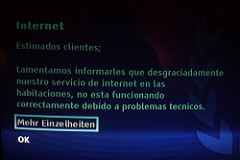
We showed Nepomuk, anticipating whatever questions come:
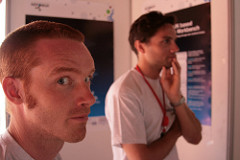
And it was good – Heiko won the best Poster.
Some scientist who gave their first presentation in front of big audiences:
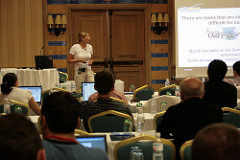
Eswc 2008 first impression
ESWC 2008 is over, and it was interesting. Best paper on combining data mining and sparql. Best poster was Heiko Hallers quikey (nepomuk) and best demo Knud Möller/Laura Dragan/Sebastian Trügs semantic desktop pipes for kde, also from the Nepomuk project. Score.
I kept chatting with interesting people about the future of the semantic desktop and my plans for bringing it to more people. During the whole event internet was rare and I currently type this on my nokia e70 at ristorant pomodoro in san telmo, they have free wifi….. Once I got web, you will see the nice pictures I did on flickr, but don’t hold your breath, from today on I am one week on holiday.
eswc rocks, and although our science is young, it can (in the words of Manfred Hauswirth) “feed itself”., and like an evolving being, starts to walk.
Mashup NMC symposium
In April 2008 there was a symposium on mashups:
http://www.nmc.org/conference/2008-spring-symposium
In their call for proposals they used a picture to illustrate the ideas of mashups:
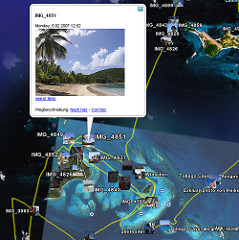
which shows a mashup I coded myself on my home linux box to combine CanonEOS400 pictures with a GPSLogger of a yacht with google earth.
The classical kissology effect: the bits we spent most time on are not as much viewed as the simple nice hacks.
